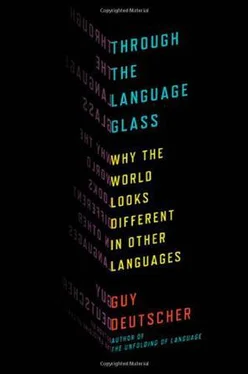HOPI TIME
What surprises most is to find that various grand generalizations of the Western world, such as time, velocity and matter, are not essential to the construction of a consistent picture of the universe.
(Benjamin Lee Whorf, Science and Linguistics )
Even the stork in the heavens knows her times. And the turtledove, the swallow, and crane keep the time of their coming. But My people know not the ordinance of the Lord.
(Jeremiah 8:7)
By far the most electrifying of Whorf’s arguments concerned a different area of grammar and a different language: Hopi from northeastern Arizona. Today the Hopi number about six thousand and are known especially for the “snake dance,” in which the performers dance with live snakes between their teeth. The snakes are then released and spread the word among their peers that the Hopi are in harmony with the spiritual and natural world. But Whorf made Hopi famous for a different reason: the Hopi language, he said, had no concept of time. Whorf claimed to have made a “long and careful study” of the Hopi language, although he never actually got round to visiting them in Arizona and his research was exclusively based on his conversations with one Hopi informant who lived in New York City. At the start of his investigations, Whorf argued that Hopi time “has zero dimensions; i.e., it cannot be given a number greater than one. The Hopi do not say, ‘I stayed five days,’ but ‘I left on the fifth day.’ A word referring to this kind of time, like the word day, can have no plural.” From this fact he concluded that “to us, for whom time is a motion on a space, unvarying repetition seems to scatter its force along a row of units of that space, and be wasted. To the Hopi, for whom time is not a motion but a ‘getting later’ of everything that has ever been done, unvarying repetition is not wasted but accumulated.” Whorf thus found it “gratuitous to assume that a Hopi who knows only the Hopi language and the cultural ideas of his own society has the same notions… of time and space that we have.” The Hopi, he said, would not understand our idiom “tomorrow is another day,” because for them the return of the day is “felt as the return of the same person, a little older but with all the impresses of yesterday, not as ‘another day,’ i.e. like an entirely different person.”
But this was only the beginning. As his investigations of Hopi deepened, Whorf decided that his previous analysis had not gone far enough and that the Hopi language in fact contains no reference to time at all. Hopi, he explained, contains “no words, grammatical forms, constructions or expressions that refer directly to what we call ‘time,’ or to past, present, or future.” Thus a Hopi “has no general notion or intuition of TIME as a smooth flowing continuum in which everything in the universe proceeds at an equal rate.”
This spectacular revelation outshone anything that anyone had previously been able to imagine, and it shot Whorf to the attention of the world. The fame of his claims quickly spread far beyond linguistics, and within a few years Whorf’s ideas were in every mouth. Needless to say, the stakes were raised with each retelling. A 1958 book called Some Things Worth Knowing: A Generalist’s Guide to Useful Knowledge reported that the English language makes it impossible for “us laymen” to understand the scientific concept of time as a fourth dimension. But “a Hopi Indian, thinking in the Hopi language-which does not treat time as a flow-has less trouble with the fourth dimension than do we.” A few years later, one anthropologist explained that for the Hopi “time seems to be that aspect of being which is the knife-edge of now as it is in the process of becoming both ‘past’ and ‘future.’ Viewed thus, we have no present either, but our linguistic habits make us feel as if we had.”
There was only one hitch. In 1983, the linguist Ekkehart Malotki, who did extensive fieldwork on the Hopi language, wrote a book called Hopi Time . The first page of the book is largely blank, with only two short sentences printed in the middle, one below the other:
After long and careful study and analysis, the Hopi language is seen to contain no words, grammatical forms, constructions, or expressions that refer directly to what we call “time.”
(Benjamin Lee Whorf, “An American Indian Model of the Universe,” 1936)
pu’ antsa pay qavongvaqw pay su’its talavay kuyvansat, pàasatham pu’ pam piw maanat taatayna
Then indeed, the following day, quite early in the morning at the hour when people pray to the sun, around that time then, he woke up the girl again
(Ekkehart Malotki, Hopi Field Notes, 1980)
Malotki’s book goes on to describe, in 677 pages of small print, the numerous expressions for time in the Hopi language, as well as the tense and aspect system on its “timeless verbs.” Incredible how much a language can change in forty years.

It is not difficult to comprehend why the principle of linguistic relativity, or the “Sapir-Whorf hypothesis,” as it has also come to be known, has sunk into such disrepute among respectable linguists. But there are others-philosophers, theologians, literary critics-who carry the torch regardless. One idea has proved particularly resilient to the onslaught of fact or reason: the argument that the tense system of a language determines the speakers’ understanding of time. Biblical Hebrew has offered particularly rich picking, as its allegedly tenseless verbal system could be relied on to explain anything from the Israelites’ conception of time to the nature of Judeo-Christian prophecy. In his 1975 cult book After Babel , George Steiner follows a long line of great thinkers in attempting to “relate grammatical possibilities and constraints to the development of such primary ontological concepts as time and eternity.” While always careful to avoid any formulation that could be nailed to a specific sense, Steiner nevertheless informs us that “much of the distinctive Western apprehension of time as a linear sequence and vectorial motion is set out in and organized by the Indo-European verb system.” But biblical Hebrew, according to Steiner, never developed such tense distinctions at all. Is this difference between the elaborate tense system of the Indo-European Greek and the tenselessness of Hebrew, he asks, responsible for the “contrasting evolution of Greek and Hebrew thought”? Or does it merely reflect preexisting thought patterns? “Is the convention that spoken facts are strictly contemporaneous with the presentness of the speaker-a convention which is crucial to Hebraic-Christian doctrines of revelation-a generator or a consequence of grammatical form?” Steiner concludes that the influence must go in both directions: the verbal system influences thought, which in turn influences the verbal system, all in “manifold reciprocity.”
Above all, Steiner argues, it is the future tense that has momentous consequences for the human soul and mind, as it shapes our concept of time and rationality, even the very essence of our humanity. “We can be defined as the mammal that uses the future of the verb ‘to be,’ ” he explains. The future tense is what gives us hope for the future, and without it we are all condemned to end “in Hell, that is to say, in a grammar without futures.”
Before you rush to get rid of your psychiatrist and hire a grammarian instead, try this quick reality check. First, on a point of order, one should mention that no one fully understands the niceties of the biblical Hebrew verbal system. There are two main verbal forms in Hebrew, and the difference between them seems to depend on some elusive mix of both tense and what linguists call aspect-the distinction between completed actions (e.g., “I ate”) and ongoing actions (“I was eating”). But let’s even grant for the sake of argument that the Hebrew verb does not express the future tense, or any other tenses at all. Need this absence have any constraining effect on the speakers’ understanding of time, future, and eternity? Here is a verse from a delightful prophecy about impending doom, where a wrathful Jehovah promises his enemies imminent retribution:
Читать дальше












